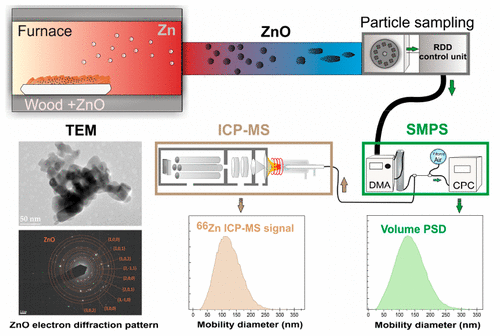当前位置:
X-MOL 学术
›
Environ. Sci. Technol.
›
论文详情
Our official English website, www.x-mol.net, welcomes your
feedback! (Note: you will need to create a separate account there.)
Emissions of Secondary Formed ZnO Nano-Objects from the Combustion of Impregnated Wood. An Online Size-Resolved Elemental Investigation
Environmental Science & Technology ( IF 10.8 ) Pub Date : 2018-01-04 00:00:00 , DOI: 10.1021/acs.est.7b03584 Debora Foppiano 1 , Mohamed Tarik , Elisabeth Müller Gubler , Christian Ludwig 1
Environmental Science & Technology ( IF 10.8 ) Pub Date : 2018-01-04 00:00:00 , DOI: 10.1021/acs.est.7b03584 Debora Foppiano 1 , Mohamed Tarik , Elisabeth Müller Gubler , Christian Ludwig 1
Affiliation

|
The release of secondary nano-objects formed during waste combustion processes is becoming a matter of concern, considering their known toxicity and the fact that the 100% efficiency of filtering systems is not always ensured. An increased cytotoxicity and genotoxicity on human peripheral blood lymphocytes is known particularly in the case of ZnO, which is often contained in paints and waterproof agents, heading to a relevant quantity present in the waste wood material. In this study, the behavior of ZnO nanoparticles during wood combustion and the effect of the reduction potential of generated carbon species on the release of secondarily formed ZnO-containing nano-objects were investigated. By hyphenating a modified scanning mobility particle sizer (SMPS) and inductively coupled mass spectrometry (ICP-MS), it was possible to obtain simultaneously size-resolved and chemical information on the emitted nanoparticles. Through the established correlation between SMPS and ICP-MS signals, Zn-containing particles were efficiently resolved from the combustion generated particles. Transmission electron microscopy (TEM) and energy-dispersive X-ray spectroscopy (EDS) on size-selected particles confirmed the SMPS and ICP-MS data. The use of electron diffraction allowed determining the structure of the crystalline materials as hexagonal ZnO. A possible mechanism of reduction of ZnO to Zn and further reformation as secondary nano-objects is proposed.
中文翻译:

浸渍木材燃烧产生的次级形成的ZnO纳米物体的排放。在线大小解析元素调查
考虑到其已知的毒性以及不能始终确保过滤系统100%效率的事实,在废物燃烧过程中形成的次级纳米物体的释放正成为一个令人关注的问题。特别是在油漆和防水剂中通常含有的ZnO的情况下,对人体外周血淋巴细胞的细胞毒性和遗传毒性增加是已知的,而在废木材料中存在相当数量的ZnO。在这项研究中,研究了ZnO纳米粒子在木材燃烧过程中的行为以及生成的碳物种的还原电势对二次形成的含ZnO纳米物体释放的影响。通过连接改良的扫描迁移率粒度仪(SMPS)和电感耦合质谱(ICP-MS),可以同时获得所发射纳米粒子的尺寸分辨信息和化学信息。通过在SMPS和ICP-MS信号之间建立相关性,可以从燃烧产生的颗粒中有效分离出含锌颗粒。尺寸选择的颗粒的透射电子显微镜(TEM)和能量色散X射线光谱(EDS)证实了SMPS和ICP-MS数据。电子衍射的使用允许将晶体材料的结构确定为六方ZnO。提出了将ZnO还原为Zn并进一步重整为次要纳米物体的可能机理。从燃烧产生的颗粒中有效地分离出含锌颗粒。尺寸选择的颗粒的透射电子显微镜(TEM)和能量色散X射线光谱(EDS)证实了SMPS和ICP-MS数据。电子衍射的使用允许将晶体材料的结构确定为六方ZnO。提出了将ZnO还原为Zn并进一步重整为次要纳米物体的可能机理。从燃烧产生的颗粒中有效地分离出含锌颗粒。尺寸选择的颗粒的透射电子显微镜(TEM)和能量色散X射线光谱(EDS)证实了SMPS和ICP-MS数据。电子衍射的使用允许将晶体材料的结构确定为六方ZnO。提出了将ZnO还原为Zn并进一步重整为次要纳米物体的可能机理。
更新日期:2018-01-04
中文翻译:

浸渍木材燃烧产生的次级形成的ZnO纳米物体的排放。在线大小解析元素调查
考虑到其已知的毒性以及不能始终确保过滤系统100%效率的事实,在废物燃烧过程中形成的次级纳米物体的释放正成为一个令人关注的问题。特别是在油漆和防水剂中通常含有的ZnO的情况下,对人体外周血淋巴细胞的细胞毒性和遗传毒性增加是已知的,而在废木材料中存在相当数量的ZnO。在这项研究中,研究了ZnO纳米粒子在木材燃烧过程中的行为以及生成的碳物种的还原电势对二次形成的含ZnO纳米物体释放的影响。通过连接改良的扫描迁移率粒度仪(SMPS)和电感耦合质谱(ICP-MS),可以同时获得所发射纳米粒子的尺寸分辨信息和化学信息。通过在SMPS和ICP-MS信号之间建立相关性,可以从燃烧产生的颗粒中有效分离出含锌颗粒。尺寸选择的颗粒的透射电子显微镜(TEM)和能量色散X射线光谱(EDS)证实了SMPS和ICP-MS数据。电子衍射的使用允许将晶体材料的结构确定为六方ZnO。提出了将ZnO还原为Zn并进一步重整为次要纳米物体的可能机理。从燃烧产生的颗粒中有效地分离出含锌颗粒。尺寸选择的颗粒的透射电子显微镜(TEM)和能量色散X射线光谱(EDS)证实了SMPS和ICP-MS数据。电子衍射的使用允许将晶体材料的结构确定为六方ZnO。提出了将ZnO还原为Zn并进一步重整为次要纳米物体的可能机理。从燃烧产生的颗粒中有效地分离出含锌颗粒。尺寸选择的颗粒的透射电子显微镜(TEM)和能量色散X射线光谱(EDS)证实了SMPS和ICP-MS数据。电子衍射的使用允许将晶体材料的结构确定为六方ZnO。提出了将ZnO还原为Zn并进一步重整为次要纳米物体的可能机理。











































 京公网安备 11010802027423号
京公网安备 11010802027423号